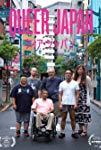Eye For Film >> Movies >> Queer Japan (2019) Film Review
Queer Japan
Reviewed by: Jennie Kermode

For fans of animé and certain aspects of Japanese teen culture, it's easy to think of the archipelago as a place where attitudes to sexuality and gender variance are quite relaxed. Indeed, historically they were, as the country's tradition of erotic art illustrates (director Graham Kolbeins provides a sampling of that here). Japan is, however, another of those countries that dramatically changed their thinking on such matters under the influence of Christianity and Western culture more generally, absorbing its multifarious taboos. What makes it interesting is that unlike others it held on to a great deal of its cultural and religious traditions, even if some practices went underground - and hentai, or sexual 'abnormality', today retains an extraordinary scope and diversity, in some aspects quite unlike anything found elsewhere.
To try and explore the full scope of this diversity in a single documentary is ambitious to say the least. Kolbeins does an impressive job. The film is packed full of information and provides a rich, enthralling experience for the viewer. Even those who have a good deal of familiarity with the subject will learn new things, whilst newcomers are likely to be dazzled. From the day to day issues faced by a lesbian couple and a trans politician to the exotic world of Department H where art and erotica merge and kaiju walk the runway, there's always more to discover. The day to day lives of those who just want to fit in and be respected - in a political landscape with a strong streak of social conservatism - sit side by side with the fantastic world of those who have responded to being pushed out of the mainstream by developing new, ever more creative ways of expressing themselves.
Particularly intriguing here is the overlap between hentai and art. There's some fabulously inventive work on display and a huge appetite for such ideas within the scene - an intellectual aspect to the erotic which recognises that its potential goes beyond mere shock or titillation. It's also interesting to see the way that Tokyo scenesters have taken forms of fetish play developed in other parts of the world and given them a distinctive twist.
Also present here are reflections on the impact of the AIDS crisis, with HIV still carrying a heavy stigma in a country which has never been great at dealing with issues around chronic illness or disability; and there's a consideration of the ways that different sexual and gender minorities have variously been at odds when they might have benefited from working together. Growing political and intersectional awareness within these communities hints that this is a situation that might improve in the future. There's a sense, throughout the film, of change and growth, of people becoming more aware of each other.
Then, of course, there's the sheer spectacle of it all. Nobody does dress-up quite like the Japanese and there are some stunning sights to see here, from giant rubber insect costumes to Harajuku drag queens, vibrant parties, colourful parades and, of course, tentacle monsters. It's all gorgeously shot by Kolbeins and fellow cinematographer John Roney, who capture a moment in time that future generations will treasure.
Reviewed on: 29 Oct 2019
















